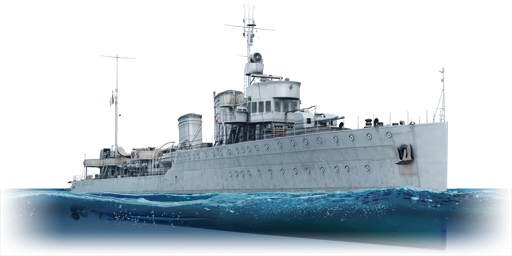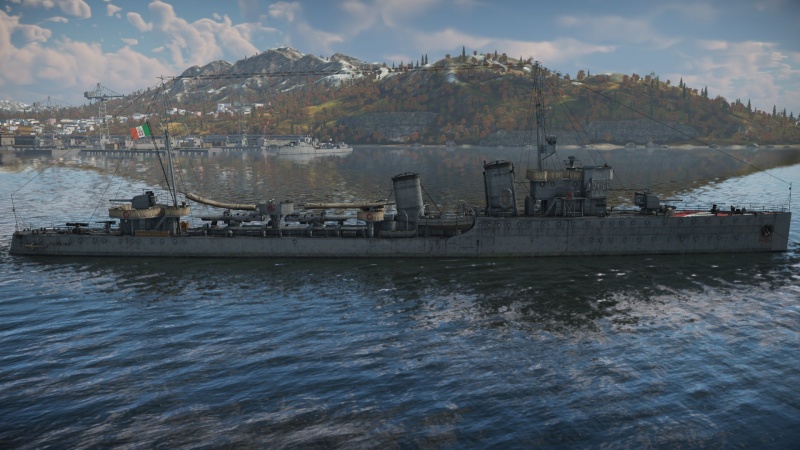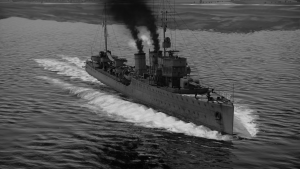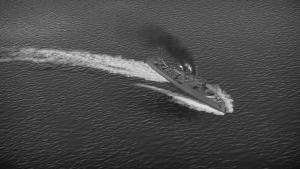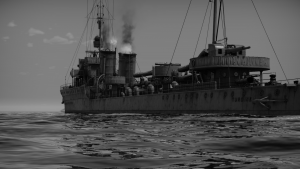RN Turbine
| This page is about the Italian Destroyer RN Turbine. For other versions, see Turbine (Family). |
Contents
Description
The RN Turbine was the lead ship of the Turbine-class destroyers, improved and enlarged versions of the preceding Sauro-class. Turbine was completed on 27th August 1927, and saw some action throughout her service life. During the Spanish Civil War, Turbine torpedoed and sank Soviet cargo ship Timiryazev carrying coal from Cardiff to Port Said. During her first war patrol on 13th June 1940, Turbine participated in the detection and sinking of British O-class submarine HMS Odin at the entrance of the Gulf of Taranto. She later also participated in the bombardment of the British-held port of Sollum, Egypt as retaliation after a British air attack on Tobruk. On 19th June, Turbine scored her second and last kill of the war, detecting another O-class submarine, HMS Orpheus, about 25 miles north of Tobruk and sinking it with depth charges. Between July and September 1940, Turbine survived multiple air attacks while at anchor in the ports of Tobruk and later Benghazi; except Euro, all her other sisters were sunk in the attacks. In 1942, Turbine underwent refit which changed her anti-aircraft weaponry to seven 20 mm Breda Model 1935 autocannons as the obsolete 40 mm pompoms were removed. Two depth charge launchers were also added. After Italy signed the Armistice, Turbine was ordered to surrender to Germany while at anchor at Piraeus, Greece. She was renamed TA14 and served in the Aegean until sunk by USAAF air attack with rockets in Salamis on 16th September 1944.
Turbine-class, RN Turbine, 1927 was introduced in Update "Starfighters" as Italian reserve destroyer. Her armament is relatively weak with very long reload of 11 sec, compared to her much faster firing contemporaries. Unlike them however, she has access to APHE shells, as well as HE-TF and standard HE shells. Turbine also has access to quite powerful torpedoes, capable of reaching speeds of up to 94 km/h, although limited to range of only 4 km. Turbine is best used as an ambusher, capable of delivering fast and deadly torpedo attacks at close range.
General info
Survivability and armour
RN Turbine is the second smallest ship at its battle rating with a hull length of 91 m compared to 93 m for Leopard or 98 m for the Soviet Frunze.
The hull is lined with 16 mm steel, in combination with Turbine's small stature this creates a perfect combination of a tough and small ship, perfect for dueling foes.
Her crew consists of 179 sailors which makes her the top vessel with the most crew members at her battle rating. In second place is Frunze with 168 and in third place is USS Barker with 150.
These ships mentioned above will be the most commonly encountered in battle, along with Type 1924 Leopard. The advantage is that all three have one thing in common, they all have little protection on the main hold.
Barker and Leopard are the most vulnerable because right next to the hold they have the main fuel tank, something the Frunze does not have.
Unfortunately, RN Turbine also suffers from this small but important problem, because during combat the front of the ship is one of the most vulnerable. To remedy this flaw, it is recommended to angle the ship slightly to the left or right (to keep the profile of the ship smaller) in the direction of enemy fire, so enemy projectiles do not find a flat surface to penetrate and blow up the main hold, knocking the ship out of battle!
Mobility
RN Turbine is equipped with 2 powerful turbines delivering 40,000 horsepower, allowing it to travel at 36 knots (66 km/h). Its draught of only 3 m makes it very agile even at its maximum speed. Its rudder can turn from left to right and vice versa in just 5 seconds.
The advantage of being small and wide increases the stability of the ship even in case of a sudden turn. RN Turbine is able to stop completely from maximum speed in 32 seconds and its maximum speed in reverse is -14 knots (-26 km/h).
| Mobility Characteristics | |||||
|---|---|---|---|---|---|
| Game Mode | Upgrade Status | Maximum Speed (km/h) | Turn Time (s) | Turn Radius (m) | |
| Forward | Reverse | ||||
| AB | Stock | 60 | 23 | ~103.68 | ~192.52 |
| Upgraded | 82 | 32 | ___ | ___ | |
| RB/SB | |||||
| Upgraded | 67 | 26 | ___ | ___ | |
Modifications and economy
Armament
Primary armament
First produced by Ansaldo in 1926, this gun was continually modified during the 1930s by both Ansaldo and Odero-Terni-Orlando (OTO).
The 120 mm/45 O.T.O. Mod. 1926 in the double mounts suffered from excessive dispersion which seems to be the result of mounting the barrels too close together. On later destroyers, a single 120 mm/50 (4.7") mount was used to replace the obsolete 120 mm/15 (4.7") star howitzers, thus improving the ship's firepower.
In combat this type of weapon is very strong at its battle rating, as it offers HE, APHE, and HE-TF ammunition.
The speed of the rounds are 850 m/s and have a reload of 8.2 seconds. HE and HE-TF have an explosive mass of 2.39 kg and APHE 1.16 kg.
The HE shells which RN Turbine can use are currently the most explosive, the Frunze only has 2.1 kg, Leopard has 2 kg, the IJN Mutsuki 1.86 kg, the USS Litchfield 1.23 kg and the HMS Churchill with only 721 g. The great velocity of its rounds guarantees an almighty success in long-distance fights.
| Penetration statistics | |||||||
|---|---|---|---|---|---|---|---|
| Ammunition | Type of warhead |
Penetration @ 0° Angle of Attack (mm) | |||||
| 1,000 m | 2,500 m | 5,000 m | 7,500 m | 10,000 m | 15,000 m | ||
| HE Dirompente | HE | 29 | 29 | 29 | 29 | 29 | 29 |
| APBC Perforante | APHE | 154 | 121 | 81 | 56 | 41 | 35 |
| HE-TF Contro-aerea | HE-TF | 29 | 29 | 29 | 29 | 29 | 29 |
| Shell details | ||||||||||||
|---|---|---|---|---|---|---|---|---|---|---|---|---|
| Ammunition | Type of warhead |
Velocity (m/s) |
Projectile mass (kg) |
Fuse delay (s) |
Fuse sensitivity (mm) |
Explosive mass (TNT equivalent) (kg) |
Ricochet | |||||
| 0% | 50% | 100% | ||||||||||
| HE Dirompente | HE | 850 | 22.11 | 0 | 0.1 | 2.39 | 79° | 80° | 81° | |||
| APBC Perforante | APHE | 850 | 23.15 | 0.025 | 6 | 1.16 | 47° | 60° | 65° | |||
| HE-TF Contro-aerea | HE-TF | 850 | 22.11 | 0 | 0.1 | 2.39 | 79° | 80° | 81° | |||
Secondary armament
Introduced into the Royal Navy in March 1915 as a large calibre MG AA. These guns used 25-round fabric belts, which are used only in single mounts. Britain produced a total of 795 cannons of which 577 were still available in 1939.
The original Mark II design was prone to many defects and the Mark II* was a modified version that improved reliability.
Stoppages and jams were still common in these models as the bullets slipped out of their mounts and the fabric belts which carried them often tore. The Mark II*C was another modification that used a 14-shot steel-link belt instead of the fabric belt. These steel-mesh belts were also used on the later 2-pdr. Mark VIIIs.
About 50 of these guns were sold to the Italian Navy. They were then manufactured under license by Terni (Italy) until the early 1930s. The Terni version used a 50-round ammunition box.
RN Turbine is equipped with no less than three 40 mm/39 Vickers-Terni mod.1915/1917 guns, 2 in the center and 1 in the rear of the ship.
This positioning guarantees complete aerial coverage within a radius of 1.1 km. Unfortunately, their short range limits the air defense of the ship, but as soon as an air target enters the maximum effective range of these anti-aircraft guns, i.e. 800 m, the aircraft will be instantly neutralized by the HE-TF rounds which use 31 g of explosive.
| Penetration statistics | |||||||
|---|---|---|---|---|---|---|---|
| Ammunition | Type of warhead |
Penetration @ 0° Angle of Attack (mm) | |||||
| 10 m | 100 m | 500 m | 1,000 m | 1,500 m | 2,000 m | ||
| 40 mm HE-TF | HE-TF | 3 | 3 | 3 | 3 | 3 | 3 |
| Shell details | ||||||||||||
|---|---|---|---|---|---|---|---|---|---|---|---|---|
| Ammunition | Type of warhead |
Velocity (m/s) |
Projectile mass (kg) |
Fuse delay (m) |
Fuse sensitivity (mm) |
Explosive mass (TNT equivalent) (g) |
Ricochet | |||||
| 0% | 50% | 100% | ||||||||||
| 40 mm HE-TF | HE-TF | 610 | 0.92 | 0 | 0.1 | 31 | 79° | 80° | 81° | |||
Additional armament
RN Turbine is equipped with 6 torpedoes S.I. 250/533,4X7,5 Type A (533 mm) and 52 Bollo P.125/1932 mines.
The torpedo launchers are arranged in a linear fashion in the central part of the ship and have a range of 180 degrees on both sides of the ship.
The torpedoes without the improved torpedo modification have a range of 4 km and travel at 76 km/h, while with the modification installed the torpedoes increase the range to 12 km, however their speed is reduced to 48 km/h.
These torpedoes have a mass of 1,781 kg and inside they contain 250 kg of explosives. After their launch, they need 50 metres to arm themselves and become completely destructive.
The 52 mines are positioned at the rear of the ships carried on rails that start from the middle of the ship and go all the way to the stern.
The mines in question have a mass of 221 kg of which 125 kg of explosives alone, once released into the sea these mines will stay stationary to float and will not detonate until a ship goes very close.
Usage in battles
RN Turbine at its battle level has a good armament composed of 4 120 mm/45 O.T.O. Mod. 1926, which can cause a lot of damage to enemy ships. HE can destroy enemy boats with one shot, APHE projectiles can cause massive damage and destroy enemy ships such as destroyers in a few shots, targeting their unarmoured or weakly protected areas.
Using the main armament as if it were anti-aircraft, you can use the HE-TF as these shots explode near the aerial target, based on the distance calculated by the crew of the ship, causing its destruction or severe critical damage. The only problem with the main guns is the reload time of 8.5 seconds. The ship has only 3 anti-aircraft guns (40 mm/39 Vickers-Terni mod. 1915 /1917) which are very powerful but their range is very low, which consequently reduces their effectiveness.
RN Turbine is the smallest reserve of all the reserve bluewater ships in the game. The ship has good speed and manoeuvrability which makes it capable of dodging enemy torpedoes. The ship can also carry mines and torpedoes, mines are deadly and can cause severe damage to destroyers making them sink very fast, while torpedoes can be modified with torpedo mode. From stock the torpedoes reach a distance of 4 km and have a speed of 76 km/h while if you use the torpedo mode modification they become much slower (48 km/h), while the distance is increased to 12 km.
RN Turbine must be used as a support ship or for side attacks; its cannons fire slowly but cause serious damage to enemy ships. It is not recommended to go to the front lines because enemies have the ability to easily destroy RN Turbine with a single well-placed shot between the main hold and the tank. The ship is also very small so it is a difficult target to hit, especially over long distances.
Pros and cons
Pros:
- Largest naval mine payload at its rank
- Effective primary armament (120 mm/45 O.T.O. Mod. 1926) and choice of ammunition (APHE, HE, HE-TF)
- Good survivability (large crew)
- Good speed (67 km/h)
- Good manoeuvrability (circa 45 seconds for a complete circle)
Cons:
- Lacks protection
- Slow reload for the primary armament it reloads in 8,5 seconds
- Slow turn rate of AA guns with 40 mm/39 Vickers-Terni mod.1915/1917
- Short range AA guns with 40 mm/39 Vickers-Terni mod.1915/1917
- The ammo rack can explode easily when hit, causing the ship to explode
- Carrying mines, if the ship is hit in the mine they will do an ammo rack explosion on the ship resulting in the total destruction of RN Turbine
History
Turbine-class
The Turbine-class comprised 8 destroyers named after winds (Turbine, Borea, Nembo, Aquilone, Euro, Espero, Zeffiro, and Ostro). It was one of the first classes of military ships after the First World War. This class succeeded fairly well, they had 2 twin turrets with 120 mm/45 O.T.O. Mod. 1926 guns with 6 torpedoes for auxiliary armament.
They fought in the war, but suffered 6 losses by 1940 and the other 2 sank after the armistice of 8 September.
The Turbine-class ships presented characteristics that can be defined as intermediate between the ships of the first post-war period and those of the 1930s. They were launched in 1927-28, and compared to their predecessors had a hull lengthened by 3 m, so as to be able to accommodate a 10% more powerful propulsion apparatus.
Propulsion was given by 2 groups of steam turbines on 2 axles, each on a funnel of different sizes (the front funnel was larger) with a modest 40,000 horsepower. The torpedo launchers were 2 triple mounts of 533 mm, there were also depth charges and, similarly to the other ships of the type in service in the Regia Marina, up to 50 mines could be carried.
The main armament was based on 2 twin turrets of 120 mm/45 O.T.O. Mod. 1926 cannons.The twin cannons allowed for a much more compact design of the ships than 4 single installations, and certainly also contributed to the aesthetic harmony of the design, more compact and powerful, but the cannons very close together interfered with each other during fire, causing a dispersion of fire that haunted the naval engineers throughout the war.
Turbine-class ships:
- RN Turbine (1927)
- RN Borea (1927)
- RN Nembo (1927)
- RN Aquilone (1927)
- RN Euro (1927)
- RN Espero (1928)
- RN Zeffiro (1928)
- RN Ostro (1928)
RN Turbine
On 24 March 1925 RN Turbine was laid down at the shipyard construction site Oderno (Genoa). It was launched on 21 April 1927, and entered into service on 27 August.
In 1932, Turbine was one of the first units of the Regia Marina to receive a fire control unit of the "Galileo-Bergamini" type, designed by the then Captain Carlo Bergamini.
In 1934, RN Turbine, Aquilone, Nembo, and Euro formed the VIIIa Squadriglia Cacciatorpediniere (VIII Destroyer Squadron) and with IVa Squadriglia, it was attached to the II Divisione Navale (II Naval Division), composed by heavy cruisers Fiume and Gorizia and framed in the 1a Squadra Navale (1st Naval Squad).
It took part in the Spanish Civil War (1936-1939) to counter the smuggling of supplies for the Spanish republican troops. During these operations, on 30 August 1937, RN Turbine torpedoed and sank the Soviet steamship Tymiryazev with the help of its sister RN Ostro.
At the entrance of Italy in the Second World War, Turbine, together with its sister ships RN Euro, Nembo, and Aquilone, composed the I Destroyer Squadron based in Tobruk.
During the night between 13 and 14 June 1940, RN Turbine and the destroyer RN Strale carried out an anti-submarine hunting mission in the Gulf of Taranto.
On 19 June, RN Turbine sank the British submarine Orpheus.
In the night between 16 and 17 September, RN Turbine was moored next to Aquilone at the main pier of the port of Benghazi, when the latter was bombed by nine aircraft of the 815th Squadron launched from the aircraft carrier HMS Illustrious: in this attack the destroyer RN Borea and the steamers Maria Eugenia and Gloriastella were sunk.
Some other units were damaged, though not critically. RN Turbine was hit in the aft rangefinder by two big pieces of shrapnel projected by the explosions on Maria Eugenia; the result was the disablement of the stern fire control equipment and the wounding of 6 men.
On 17 September, RN Turbine and Aquilone received orders to move to Tripoli and sailed at 20:15 directly to that base, but half an hour later RN Aquilone hit two mines and began to sink.
Initially it was not understood what had provoked the explosions and, fearing another attack from the sky, Turbine accelerated and began to zigzag, and then tried to contact its sister unit, from which there was no answer; before RN Turbine could reverse course, it was ordered to continue to Tripoli, to avoid being hit by ordnance during its turn.
On 4 July 1942, RN Turbine escorted a convoy composed by the motorboats Ankara, Nino Bixio and Sestriere, together with the destroyers Corsaro, Legionario, Folgore, Grecale, and Saetta, as well as the torpedo boats Partenope and Calliope; the ships reached their destination in spite of numerous air attacks; on that occasion there was also the first attack conducted by American aircraft against Italian units (it was an attack by Consolidated B-24 Liberator bombers).
In the last phase of the war it was employed in the Aegean.
In 1943, at the proclamation of the armistice, RN Turbine was in Piraeus. The crew initially rejoiced at the news, thinking that the ship would return home; while the crews of two tugboats came on board asking to be allowed to return to Italy with RN Turbine, the order was given to put the boilers under pressure.
At nine o'clock in the evening the commander of the destroyer, temporarily absent for shore engagements, returned aboard the ship, while the initial jubilation was replaced by concern: communications between RN Turbine and the other ships had failed, and the crew was sent to battle stations, while the ship was positioned in the channel leading to the port.
A few minutes after midnight, the commander of the German minelayer Drache came aboard RN Turbine and explained that the Italian destroyer was under fire from German 150 mm coastal batteries, which would open fire if the unit attempted to leave; in addition, Drache had just laid a new minefield outside the harbor.
Moreover, even if the destroyer had managed to get away unscathed, it would have been attacked by Luftwaffe aircraft stationed in Athens as the sun rose. At dawn, having ascertained the truth of this fact, the crew prepared to scuttle the ship, while the commander went ashore; at ten o'clock in the morning the order to turn off the boilers was received, while at 11:20 the commander returned aboard RN Turbine and explained that the command of the Italian troops in Greece had ordered to deliver the ship intact to the Kriegsmarine.
On September 9, 1943 the ship was delivered intact by its crew to the German troops; some members of the crew opted to remain on board and continue to fight with the Germans, while most of the staff, after having disembarked on the promise of a safe return to Italy, were sent to prison camps in Germany and Poland.
Incorporated into the Kriegsmarine, RN Turbine assumed the new name TA 14.
After a refit, the Germans added 20 mm machine guns to the ship, it was assigned to the 9th Torpedo Flotilla and took part in the occupation of Rhodes at the end of 1943, then it was employed in the Aegean with escort duties.
On 1 February 1944, it was hit with rockets and damaged by British aircraft. Repaired at Salamina, it briefly resumed escort duty. On June 19, while in Portolago (Leros), it was again damaged by explosive charges placed by British raiders.
On 16 September 1944, while in Salamina for repairs, it was hit by bombs and sunk during an American aerial bombardment.
Since the entry into service of RN Turbine, in the long convoy war 1940-1943, in addition to the sinking of the Orpheus, five enemy torpedo bombers were shot down.
Media
- Skins
- Videos
See also
External links
Paste links to sources and external resources, such as:
- topic on the official game forum;
- other literature.
| Odero-Terni-Orlando Company | |
|---|---|
| Destroyers | |
| Turbine-class | RN Turbine · RN Aquilone |
| Dardo-class | RN Dardo |
| Soldati-class | RN Corazziere · RN Aviere · RN Geniere |
| Comandanti Medaglie d'Oro-class | RN Comandante Margottini |
| Light Cruisers | |
| Condottieri-class | Kerch* · RN Duca degli Abruzzi |
| Capitani Romani-class | RN Attilio Regolo · Guichen** |
| Heavy Cruisers | |
| Trento-class | RN Trento |
| Zara-class | RN Zara · RN Pola |
| Battleships | |
| Conte di Cavour-class | RN Leonardo da Vinci*** |
| Export | Tashkent**** |
| See Also | OTO Melara |
| *RN Duca d'Aosta before war reparation to the USSR | |
| **RN Scipione Africano before war reparation to France | |
| ***Previously ‘’Cantieri navali Odero’’ in Genoa-Sestri Ponente | |
| ****Built for the USSR | |
| Italy destroyers | |
|---|---|
| Regia Marina | |
| Aquila-class | RN Aquila |
| Leone-class | RN Leone · RN Tigre |
| Turbine-class | RN Aquilone · RN Turbine |
| Navigatori-class | RN Da Verazzano |
| Dardo-class | RN Dardo |
| Soldati-class | RN Aviere · RN Corazziere · RN Geniere |
| Comandanti Medaglie d'Oro-class | RN Comandante Margottini |
| Marina Militare | |
| Fante-class* | Geniere |
| Indomito-class | Impetuoso |
| * Modified Fletcher-class destroyers | |


